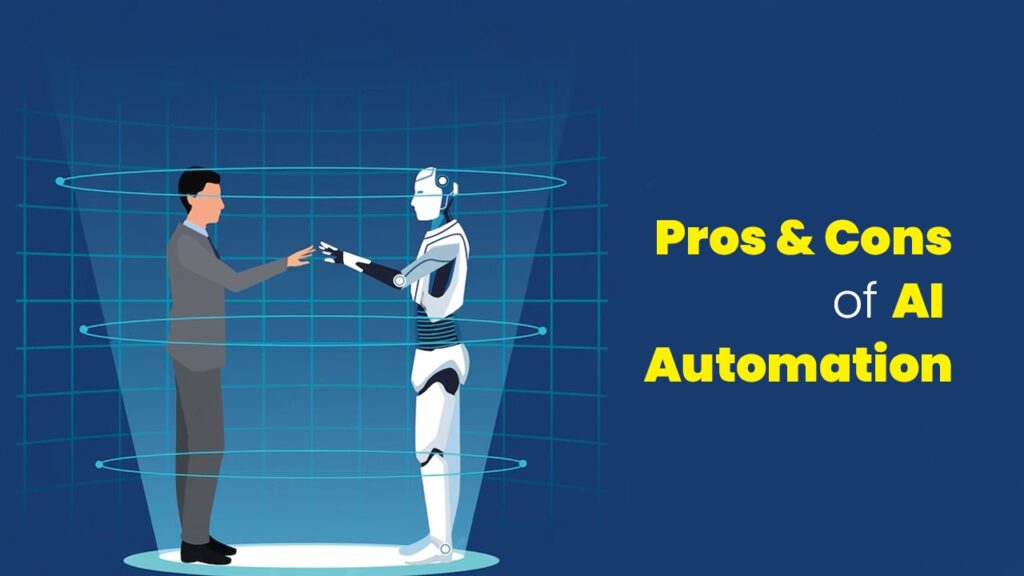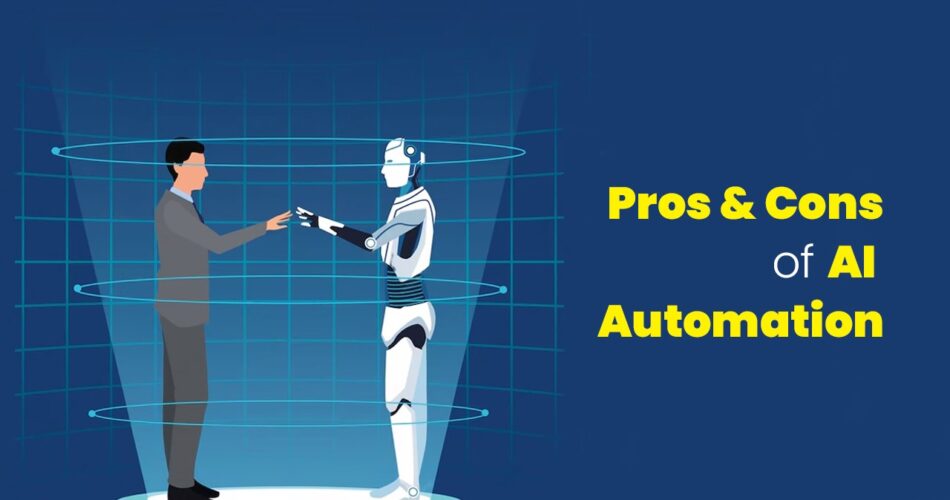
Introduction:
Artificial Intelligence (AI) automation is revolutionizing the IT industry by providing opportunities for increased efficiency, accuracy, and productivity. With the ability to automate repetitive and mundane tasks, AI automation is transforming the IT industry, leading to cost savings and improved decision-making abilities. However, while AI automation has significant advantages, there are also drawbacks to consider. One of the most significant risks is job displacement, which can have severe economic consequences. In this blog, we will explore the pros and cons of AI automation in the IT industry and discuss real-world examples of AI automation in action. We will also examine the potential impact of AI automation on the job market and workforce.
Pros of AI Automation in the IT Industry:
Increased efficiency and productivity:
AI automation can help businesses optimize their workflows and reduce the time it takes to complete tasks. At Pepy Technologies ,we can lead to increased efficiency and productivity, allowing businesses to achieve their goals more quickly and with greater accuracy. For instance, AI-powered chatbots can help businesses respond to customer inquiries quickly and efficiently, leading to improved customer satisfaction.
Improved accuracy and precision:
AI automation can reduce the risk of errors and mistakes, improving the accuracy and precision of tasks. For example, AI algorithms can analyze vast amounts of data and identify patterns that humans may not be able to detect. This can help businesses make more informed decisions based on accurate and reliable data.
Reduction in errors and mistakes:
AI automation can significantly reduce the risk of errors and mistakes, leading to higher-quality products and services. For instance, AI algorithms can be used to check for errors in software code, reducing the risk of bugs and security vulnerabilities.
Time-saving benefits:
AI automation can free up time for employees to focus on higher-level tasks, such as strategic planning and decision-making. This can lead to increased productivity and creativity, allowing businesses to innovate and stay ahead of the competition.
Cost-saving benefits:
AI automation can reduce costs by automating repetitive and mundane tasks, leading to increased efficiency and productivity. For instance, AI-powered systems can be used to automate billing and invoicing processes, reducing the need for manual labor and lowering costs.
Overall, the pros of AI automation in the IT industry are significant and can lead to increased efficiency, accuracy, productivity, and cost savings for businesses.
Cons of AI Automation in the IT Industry:
Job displacement and skills gap:
One of the most significant risks of AI automation in the IT industry is job displacement. As AI automation continues to evolve, many jobs that were previously done by humans may become automated, leading to job losses and a skills gap. This can have severe economic consequences for individuals and communities, and it is essential for businesses to prepare for the impact of AI automation on the workforce.
Cost of implementation and maintenance:
Implementing AI automation can be expensive, and maintaining the systems can also be costly. This can be a barrier to entry for small businesses and startups, limiting their ability to take advantage of the benefits of AI automation.
Lack of human interaction:
AI automation can lead to a lack of human interaction in the workplace, leading to decreased employee engagement and job satisfaction. This can have negative impacts on productivity and creativity, and it is important for businesses to find ways to balance the use of AI automation with human input and collaboration.
Dependence on technology:
AI automation can lead to dependence on technology, making businesses vulnerable to system failures and cyber-attacks. It is essential for businesses to have contingency plans in place to mitigate these risks and ensure the safety and security of their data and systems.
Ethical considerations:
AI automation raises ethical considerations, such as the potential for biased algorithms and the impact on privacy and data protection. It is essential for businesses to consider these ethical implications and ensure that their use of AI automation is aligned with their values and principles.
Overall, the cons of AI automation in the IT industry highlight the need for careful consideration and planning to ensure that businesses can take advantage of the benefits of AI automation while minimizing the risks and drawbacks.
Cons of AI Automation in the IT Industry:
Job displacement and skills gap:
One of the most significant risks of AI automation in the IT industry is job displacement. As AI automation continues to evolve, many jobs that were previously done by humans may become automated, leading to job losses and a skills gap. This can have severe economic consequences for individuals and communities, and it is essential for businesses to prepare for the impact of AI automation on the workforce.
Cost of implementation and maintenance:
Implementing AI automation can be expensive, and maintaining the systems can also be costly. This can be a barrier to entry for small businesses and startups, limiting their ability to take advantage of the benefits of AI automation.
Lack of human interaction:
AI automation can lead to a lack of human interaction in the workplace, leading to decreased employee engagement and job satisfaction. This can have negative impacts on productivity and creativity, and it is important for businesses to find ways to balance the use of AI automation with human input and collaboration.
Dependence on technology:
AI automation can lead to dependence on technology, making businesses vulnerable to system failures and cyber-attacks. It is essential for businesses to have contingency plans in place to mitigate these risks and ensure the safety and security of their data and systems.
Ethical considerations:
AI automation raises ethical considerations, such as the potential for biased algorithms and the impact on privacy and data protection. It is essential for businesses to consider these ethical implications and ensure that their use of AI automation is aligned with their values and principles.
Overall, the cons of AI automation in the IT industry highlight the need for careful consideration and planning to ensure that businesses can take advantage of the benefits of AI automation while minimizing the risks and drawbacks.
Real-World Examples of AI Automation in the IT Industry:
Chatbots:
Chatbots are AI-powered tools that can engage with customers and provide support and assistance 24/7. They can be used for a variety of purposes, such as answering customer queries, booking appointments, and providing product recommendations. Chatbots are increasingly being used by businesses in the IT industry to improve customer service and efficiency.
Predictive maintenance:
Predictive maintenance is a process that uses AI algorithms to predict when equipment is likely to fail, allowing for proactive maintenance and reducing downtime. This can save businesses in the IT industry significant amounts of time and money, as well as improve operational efficiency.
Cybersecurity:
AI automation is being used in the IT industry to improve cybersecurity by identifying potential threats and vulnerabilities in real time. AI algorithms can analyze large amounts of data and detect patterns that may indicate a cyber attack, allowing for swift action to be taken to prevent or mitigate the impact of the attack.
Data analysis:
AI automation is being used in the IT industry to analyze large amounts of data quickly and accurately, allowing for insights to be gained that can inform business decisions. This can include analyzing customer behavior, identifying trends, and predicting future outcomes.
Autonomous vehicles:
The development of autonomous vehicles is a significant example of AI automation in the IT industry. These vehicles use a combination of sensors, machine learning algorithms, and other technologies to operate without human intervention. Autonomous vehicles have the potential to revolutionize transportation, logistics, and supply chain management, and are already being tested and used in a variety of real-world scenarios.
Overall, these examples demonstrate the wide range of applications for AI automation in the IT industry and the potential benefits that can be achieved through the use of these technologies.
Future of AI Automation in the IT Industry:
Increased Adoption:
As AI automation technology becomes more advanced, its adoption in the IT industry is expected to increase significantly. This will lead to more efficient and effective business operations, improved customer service, and enhanced decision-making capabilities.
Greater Integration:
AI automation is expected to become more integrated with other technologies, such as the Internet of Things (IoT), blockchain, and cloud computing. This integration will allow for even greater automation and optimization of business processes.
Enhanced Personalization:
AI automation is expected to enable even greater levels of personalization in customer service and marketing. By analyzing customer data in real time, businesses will be able to provide tailored experiences and recommendations that meet the individual needs and preferences of each customer.
Increased Efficiency:
As AI automation becomes more prevalent in the IT industry, it is expected to lead to greater efficiency and productivity. This will allow businesses to accomplish more with less, reducing costs and improving profitability.
New Job Opportunities:
While AI automation may replace some manual jobs, it is also expected to create new job opportunities in areas such as data analysis, machine learning, and AI programming. These roles will require a high level of technical expertise and offer opportunities for career advancement.
Overall, the future of AI automation in the IT industry is bright, with a range of potential benefits for businesses and consumers alike. As technology continues to advance, businesses that embrace AI automation are likely to gain a significant competitive advantage in the marketplace.
Conclusion
In conclusion, AI automation has become an increasingly important part of the IT industry, with a range of potential benefits and drawbacks. While AI automation can lead to greater efficiency, productivity, and personalization, it also has the potential to displace workers and raise concerns about privacy and security. As such, it is important for businesses and policymakers to approach AI automation with caution, carefully weighing the potential benefits and drawbacks of this technology. Ultimately, the successful adoption of AI automation in the IT industry will require a careful balancing of these factors, with a focus on maximizing the benefits while minimizing the risks.

